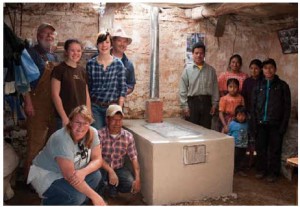
By Liz Ballantyne-Jackson
It’s a little known problem in the west, but exposure to smoke from cooking fires kills approximately two million people worldwide every year. Globally, nearly three billion people use polluting, inefficient stoves or open flames to cook their food. This results in deforestation, carbon emissions and numerous health issues.
Breathing in the toxic fumes while preparing tortillas and frijoles puts women and children at risk for blindness, respiratory illnesses and burns on a daily basis. In Guatemala alone, about 77 percent of families use wood as their main fuel source. As a result, nearly two percent of Guatemala’s forest is lost annually, mainly due to the need for cooking-fire fuel. And gathering the wood requires precious family resources and time.
The situation is similar throughout Central and South America and the issue is slowly gaining global attention through agencies such as the Global Alliance for Clean Cookstoves, a public/private UN initiative, but in the meantime, a small group of Canadian volunteers is working steadily to make a difference, one stove and one family at a time.
A trained mason can make an improved cooking stove in less than a day. These stoves, which are compatible with local cooking methods, are made of cement blocks on the outside and fire bricks inside, filled with sand for insulation and held together by mortar made from various combinations of Portland cement, sifted sand, pumice and lime. The “plancha” or stove-top, is made of shiny, bright steel with burner-type openings. The crowning glory of this low-tech kitchen “appliance” is the chimney pipe that takes the poisonous smoke out of the house. It’s a big step up from cooking on the floor over an open fire, as most women do in rural Guatemala.
Each year, in an effort to do their part, a group of Canadians travels on a volunteer awareness trip to the western highlands with the Guatemala Stove Project. Working in small groups with a mason and a Spanish translator, they spend several days in the homes of the Mayan families who have been chosen to receive these stoves. The Canadians experience their living conditions and feel the sting of the smoke in their eyes from the unvented cooking fires. They quickly develop an understanding of how poverty affects those who live on less than two dollars a day.
Upon returning to Canada, the volunteers work to raise funds for more stoves, which will be built throughout the year by trained Guatemalan masons. This generates employment and supports local businesses that make, sell and deliver the stove parts and materials to the mountain villages.
The Guatemala Stove Project is a volunteer-driven non-profit organization founded by Canadian builder Tom Clarke who first started building the justa-style stoves in 1999. The project has since funded close to 5,000 stoves, which means 5,000 families are living in cleaner houses, breathing unpolluted air.
The project’s core activity continues to be the building of stoves, but it has also provided funds for a sustainable nutrition program for a needy village, emergency relief funds in the aftermath of hurricanes and mudslides and a mobile medical clinic to provide services in remote mountain villages. It currently funds micro-loans to help subsistence farmers purchase livestock and provide members of women’s artisan groups with cash to purchase craft supplies. In another region, the project is helping fund a gravity-fed system to bring water to an isolated mountain community. With all of these projects, the participation and labour of the community members is crucial.
The work Tom Clarke began 13 years ago continues to inspire volunteers because of its grassroots approach and the immediate positive effect of the stoves. Women and children, in particular, breathe better; the women spend less time cooking, which allows them to help generate income for their families and the stoves also reduce carbon emissions and pressure on local forests. In short, there is a global benefit to providing improved cooking stoves to developing countries. And for the dozens of local stove project volunteers and supporters, it’s a more down-to-earth way to share some of Canada’s good fortune. Whichever way you look at it, it makes good sense to fund improved cooking practices. Cooking should sustain us, not kill us.
Liz Ballantyne-Jackson is a Guatemala Stove Project volunteer.




